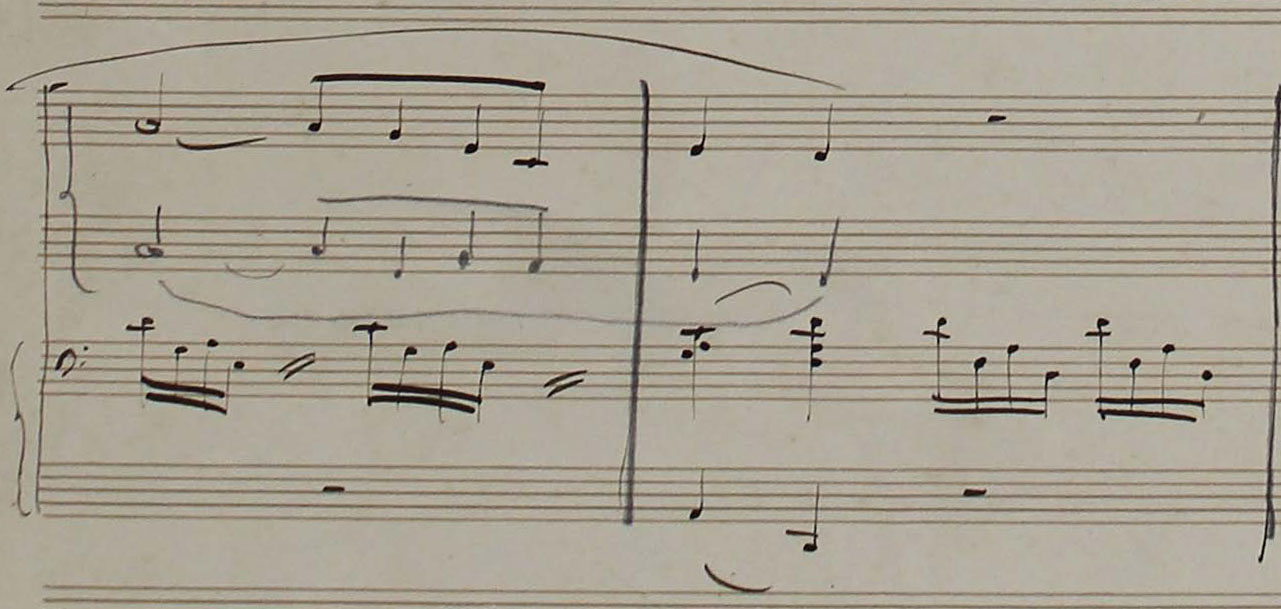Anyone who compares the edition currently on the market of Saint-Saëns’ Romance for Flute and Piano op. 37 from the original publishing house Durand with its first edition appearing in 1874 will quickly notice a striking difference in measure 102, at the end of the piece’s repeatedly varied main idea:
When reviewing the piece’s sources, we come across the following notation of the place in question in the first extant autograph manuscript (1871):
As in previous measures, Saint-Saëns entered the flute part in each of the top staves of the four-stave accolades, the piano part in the two lower staves. He clearly first notated the variant I that we know from the current Durand edition in ink, but later pencilled variant II into the blank second stave, as printed in the first edition. That this is not a correction is apparent not only because he did not delete the initial version, but also because there is a brace around both variants. So, it’s an alternative, not a correction. Since there are no direct musical reasons for imposing the alternative – the harmony (A-flat7) stays the same –, we suppose that this is about simplifying the execution.
And indeed, as the flute teacher Christel Drebes-Heinemann demonstrated to me, the little finger is especially needed for the sequence g flat1–e flat1–c1 | e flat1–d flat1 in measures 102 f. For the little finger first of all has to play a flat1 and g flat1, then stay there for the e flat1, changing position after that each time for the sequence c1–e flat1–d flat1. These fingering acrobatics are especially hard on the little finger.
F = little finger
We may assume that the execution of this passage was no problem for the then famous flutists, such as the dedicatee Amadée de Vroye, as well as later for Paul Taffanel, with whom Saint-Saëns performed the Romance; but they would probably have let the composer know that the tone sequence in measure 102 is an awkward spot.
The autograph findings entail a series of questions that can be only partially answered. Saint-Saëns provided ossias in several of his works for such difficult or at least inconvenient passages, for example, the simplifications (single notes instead of intervals) marked as “Facilités” for the right hand of the solo part in the Presto Finale of the 2nd piano concerto (HN 1355), or the so-called ossias (chords instead of semiquaver violin passages) in the closing sections of the 1st violin sonata (HN 572). Why didn’t he also do this in the case of the Romance? The publisher would certainly have been willing to include an ossia here: variant I in the main text, variant II as “Facilité” on an ossia line above it…
Back to the source situation: The already mentioned first autograph manuscript did not serve as engraver’s model for the first edition three years later. There must have been a second, currently lost manuscript that might perhaps have been a fair copy rewritten for the print; but which of the variants was notated there remains unclear. It could be that the early performances, including the premières for the versions for piano as well as also for orchestra (Baden-Baden, 8 und 13 July 1871), were still given with variant I in measure 102. After that, and in fact during proofreading the galleys in 1874, Saint-Saëns must have decided to change to variant II. Even though no documents are extant, the first edition would probably not have appeared in any case without the composer’s authorisation. At that point in time, he unequivocally considered that the easier-to-execute version was the only one to have printed.
When and why then was variant I reintroduced in later editions? Evidently, in the publication of the orchestral version in 1897, notating variant I there according to the engraver’s model, an undated copy, led crucially to the change in the piano version; after 1897, in any case, all prints show variant I. Was the modification undertaken on the part of the publishing house, or was it Saint-Saëns himself, who returned to his first inspiration? We have, unfortunately, no answer here; it may be that he tolerated both variants, but – for whatever reason – did not want to decide for an ossia in either the piano or orchestral version. The new Henle edition, soon to be published (HN 1354), now makes up for this, for today’s flutists should certainly know about the decision for variant II, uncontested for at least a long time, whilst of course the original variant I, usually played today, should not be withheld:
We reproduce variant II in the main text simply because for us the first edition of the piano version constitutes the main source, though this does not imply any evaluation here – it is up to the interpreter to make a choice, since ultimately the composer’s will is not to be deciphered.






It’s very interesting to learn of the alternative passage detailed above. However, I think that the point about the difficulty of the passage down to C has been somewhat over-stated: any player competent enough to play the piece as a whole should have no great problem in negotiating it.